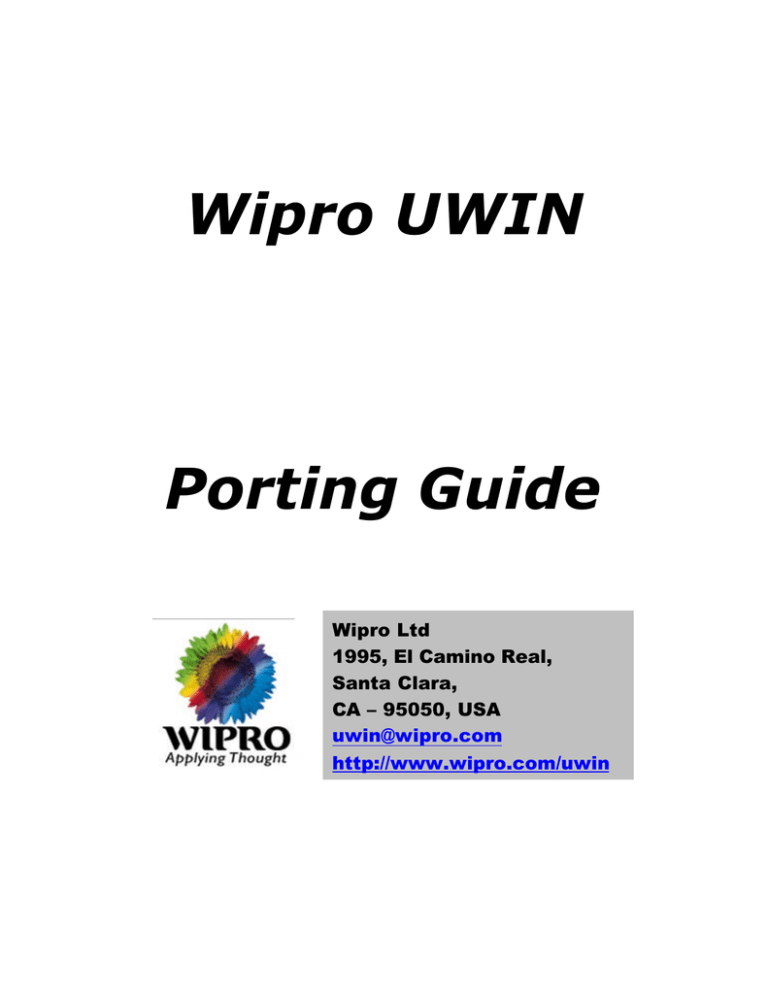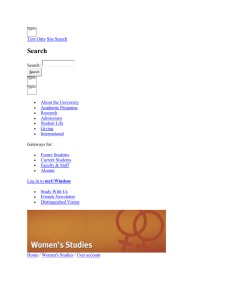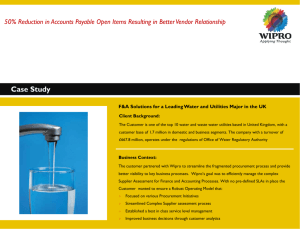
Wipro UWIN
Porting Guide
Wipro Ltd
1995, El Camino Real,
Santa Clara,
CA – 95050, USA
uwin@wipro.com
http://www.wipro.com/uwin
Wipro UWIN 2.0 – Porting Guide
Copyright © 1997-1999 Wipro Ltd.
All rights reserved. No part of this document may be reproduced or
transmitted in any form or any means without the prior written
permission of Wipro Ltd., 1995, El Camino Real, #200, Santa Clara,
CA 95050, USA.
Wipro Ltd. has made every effort to ensure the accuracy and
completeness of all information in this document. However, Wipro
assumes no liability to any part for any loss or damage caused by
errors or omissions or by statements of any kind in this document,
its updates, supplements, or special editions, whether such errors,
omissions or statements result from negligence, accident, or any
other cause. Wipro assumes no liability arising out of applying or
using any product or system described herein nor any liability for
incidental or consequential damages arising from using this
document. Wipro makes no guarantees regarding the information
contained herein (whether expressed, implied, or statutory),
inclu ding implied warranties of merchantability or fitness for a
particular purpose.
All brand names, trademarks, and registered trademarks are the
property of the respective holders. Use of a term in this document
should not be regarded as affecting the validity of any trademark or
service mark.
Wipro reserves the right to make changes to any information herein
without further notice.
2
Wipro UWIN 2.0 – Porting Guide
CONTENTS
GETTING STARTED ................................................................................................... 5
I NTRODUCTION...............................................................................................................5
R EQUIREMENTS TO PORT AN APPLICATION..........................................................................5
S ERVICES AND SUPPORT FROM W IPRO ..............................................................................5
Services ...................................................................................................................5
Training Programs ..................................................................................................6
APPLICATION P ORTING .......................................................................................... 9
O VERVIEW OF THE P ORTING P ROCESS ..............................................................................9
Preparing the application for porting....................................................................9
Preparing to Build ................................................................................................ 10
Dealing with header files and libraries .............................................................. 10
Compiling and Linking Applications.................................................................... 11
Debugging applications ....................................................................................... 11
Packaging and Deploying Applications............................................................... 12
API-SPECIFIC PORTING ISSUES.........................................................................13
P ROCESS MANAGEMENT APIS ....................................................................................... 13
S ECURITY APIS ........................................................................................................... 13
FILE M ANAGEMENT APIS .............................................................................................. 14
M ISCELLANEOUS APIS ................................................................................................. 14
PORTING TO WINDOWS 9X..................................................................................15
D IFFERENCES BETWEEN W INDOWS NT AND 9 X............................................................... 15
APIs ...................................................................................................................... 15
Services ................................................................................................................ 15
Security ................................................................................................................ 15
Error Logging ....................................................................................................... 16
Process IDs .......................................................................................................... 16
3
Wipro UWIN 2.0 – Porting Guide
4
Wipro UWIN 2.0 – Porting Guide
Chapter 1
Getting Started
Introduction
This section deals with the minimum modules of UWIN required to
port an application from Unix to Windows NT/9x. Also, the different
types of services and support offered by Wipro to the developer.
Requirements to port an application
The minimum requirement to port an application from Unix to
Windows system using UWIN is to get the UWIN base toolkit and
UWIN-SDK (UWIN Software Develo pment Kit) installed. In addition
to this, the developer should have either GNU gcc or Microsoft
Visual C++ compiler to compile the application.
For the list of prices regarding each of the UWIN packages either
visit the website http://www.wipro.com/uwin or send a mail to
uwin@wipro.com
Services and Support from Wipro
Wipro has dedicated software professionals who can provide
services and support to help the developer in porting the
applications. Below are the details for contacting the team.
Services
Wipro provides the following services.
• UWIN – Getting started
• Migration support services
• Turnkey Migration services
• Training program
UWIN - Getting Started
This is a short term consulting service aimed at customers who
have in-house Unix expertise and want to apply the same for
porting the application from Unix to Windows systems using UWIN.
5
Wipro UWIN 2.0 – Porting Guide
This program will impart the developer a thorough knowledge of the
following issues.
• Issues in porting Unix applications to Windows which include the
dependencies, hurdles, constraints, performance
• Cost benefit analysis
Migration Support Services
This program will assist the developer in porting the Unix
applications to Windows NT/9x. This program will look into the
problem at hand that has already been carried out by the migration
team of the customer, and advise them in formulating the future
course of action.
Turnkey Migration Services
This program is focused towards organizations that would hire a
Migration Solution Provider, like Wipro for the entire migration
activity on a turnkey basis.
This comprehensive program covers the following issues:
• Drawing up the Requirement Specification for the Migration task
• Identifying key phases involved in the project
• Preparing a Detailed Plan for carrying out the Migration
Training Programs
The training programs offered by Wipro are targeted at providing a
good understanding of the product and its features.
The following types of training programs are available:
• UWIN from a Users perspective
• Migrating applications to Windows using UWIN
• Interoperability between Unix and Windows
UWIN from a Users perspective
This training program is targeted towards users who would like to
use UWIN as a 'Unix utilities for Windows' Toolkit. UWIN will be
presented to the users as a tool with a rich set of Unix commands,
shells and utilities on Windows. Stress will be given on the following
topics:
• Usage of shell scripting features of UWIN using Kornshell93
(ksh93)
• Scheduling and automating tasks using cron jobs
• Interfacing with the underlying Windows OS features using UWIN
• Using the UWIN Terminal Emulator
• Working with UWIN X11 applications (xterm, etc)
6
Wipro UWIN 2.0 – Porting Guide
•
•
Setting up sendmail mail server and bind DNS server on UWIN
Improving cost-effectiveness and productivity using UWIN
Migrating applications to Windows using UWIN
This training program is targeted to those who would like to use
UWIN as a Unix application development platform on Windows. This
program will co ver the basic understanding of UWIN from users'
perspective apart from the application development aspects.
The topics covered are:
• UWIN as a Unix application development platform on Windows
• Using the UWIN cc compiler with a native Windows compiler
• Working with UWIN header files and libraries
• Developing X11 applications on Windows
• Creating shared libraries and Windows DLLs using UWIN
• Using UWIN GNU gcc compiler on Windows
• Deploying UWIN applications on Windows based systems
Interoperability between Unix and Windows
This training program helps users in exploring the issues involved in
working with both Unix and Windows operating systems. The
different issues ranging from user-interaction to application
development will be covered. All available Unix-NT Integration and
migration products will be discussed.
7
Wipro UWIN 2.0 – Porting Guide
8
Wipro UWIN 2.0 – Porting Guide
Chapter 2
Application Porting
This chapter describes the different steps involved in porting an
application from Unix to Windows NT/9x using UWIN.
Overview of the Porting Process
Before porting an application, the developer has to prepare the
application for porting. The process of porting involves the following
steps:
• Preparing the application for porting
• Preparing the application for building
• Dealing with missing header files and libraries
• Compiling and linking the Application
• Debugging the application
• Packaging and deploying the application
The responsibility of the developer in each step is described in detail
in the subsequent paragraphs.
Preparing the application for porting
Before porting an application, the developer has to decide the
following:
• Determine the possibility of porting
• Access the source files
• Select a work environment
Determine the possibility of porting
Some applications may require some other tools to run them, which
might not be available on UWIN. Under such circumstances, before
porting that application to Windows NT/9x, the developer should
make sure that the required tools are already ported on UWIN.
Otherwise, it will not be possible to execute the ported application
on UWIN.
Already a few tools have been ported to UWIN, the list of which can
be obtained from http://www.wipro.com/uwin/. If required, the
developer can download them free of cost.
9
Wipro UWIN 2.0 – Porting Guide
Access the source files
One of the commonly faced problems while copying source files to
target operating system is line termination. The line termination in
case of Unix is a line -feed character whereas in Windows, it is a
carriage return and a line-feed. In order to convert the file to Unix
format, the developer can make use of the utility /bin/nocrnl.
Example:
If my_app.c file is copied to WinNT/9x, the execution of the
following command will convert the file my_app.c to Unix format.
$ nocrnl my_app.c
Transferring the source files to the target operating system can be
achieved through ftp or rcp and the archive can be expanded using
pax or tar. The information for these commands can be obtained
from the appropriate man pages.
Select a work environment
The developer has to decide the environment to which the
application is to be ported. It can be Windows NT workstation or
server, Windows 95, or Windows 98. UWIN ensures that when an
application is ported on one work environment, it runs on all other
environments as long as the underlying platform supports the
features that the application requires. Some features like security is
not available on all work environments. The developer can opt for
gcc or cc (that internally calls Windows native C compiler) to
compile the application.
Preparing to Build
If the application involves a makefile, it has to be converted to Unix
format so that UWIN make/nmake recognizes it properly. The
format conversion can be achieved by the utility /bin/nocrnl as
described in the section Access the source files above. UWIN comes
with AT&T nmake and GNU make. Hence the developer may need to
make changes to the makefile so that is can be interpreted
properly.
For application that does not have makefile, it is not necessary to
convert all source and header files to Unix format.
Dealing with header files and libraries
While porting the application, the developer may have to resolve
issues that arise due to the UWIN provided and the own headers
and libraries of the application. During the time of compilation if any
conflict arises, the compiler search path should be given so that it
10
Wipro UWIN 2.0 – Porting Guide
first takes the local headers/libraries and then the UWIN
headers/libraries or vice-versa.
Example:
$ cc –I<path> -o test.exe test.c
where <path> is the place where the header/libraries are
present.
Compiling and Linking Applications
While compiling an application on UWIN, developer might need to
make minor changes in the source code in some cases. UWIN aims
at ‘single source, multiple deployment’ concept. However, at times
the code being compiled/linked may not be X/Open compliant. In
such cases, the developer must do some modifications in the code
to make it X/Open compliant. The amount of effort that the
developer needs to put to make this change depends on what
percentage of the code is not compliant.
UWIN makes it possible to mix Win32 and Unix APIs at the source
level. However, the developer is advised to make use of only Unix
APIs to get the desired result. If the APIs are mixed, a single source
base for both Unix and Windows environment cannot be
maintained.
Debugging applications
If it is required to debug an application, the binaries should be built
with the debug option.
Example:
If my_app.c is the application that needs to be debugged,
then build the binary as follows:
cc –g –o my_app.exe my_app.c
Now, my_app.exe contains the debug information. If the application
has been compiled through a makefile, then putting the below line
in the makefile will generate a debug version of it.
CCFLAGS=-g
After this, the application can be debugged using Microsoft Visual
Studio IDE. For more information on debugging an UWIN application
under the IDE, please refer to Chapter 4: Debugging Using Visual
C++ IDE in the developer guide.
The application can also be debugged using GNU gdb if the binary is
built using GNU gcc compiler.
11
Wipro UWIN 2.0 – Porting Guide
The UWIN trace command can be used to debug an application at
the system call level.
Example:
To trace the Unix APIs that my_app.exe calls, the below
command can be used.
$ trace –it –o outfile.log my_app.exe <arguments>
where <arguments> are the command line arguments that
the application takes when run normally.
The output of trace command will now be available in the file
outfile.log. The file outfile.log will contain all the Unix API calls made
by my_app.exe along with the values of arguments passed and the
return value from them.
To trace a daemon (like inetd.exe) and applications started by a
daemon the below method must be used.
To start the tracing use the command:
$ /etc/traceit <daemon_name>
where <daemon_name> is the name of the daemon.
And to stop the tracing use the command:
$ /etc/traceit –d <daemon_name>
The
log
files
can
be
found
under
the
directory
/tmp/log/<daemon_name>. The log file will contain all the Unix API
calls made by the daemon along with the values of arguments
passed and return value from them.
Packaging and Deploying Applications
The developer can archive the files using the UWIN utilities like pax
or tar and use it to deploy the application at the customer location.
In this case, the customer should have access to UWIN utilities (pax
or tar) to unpax the archive. This method is suitable when the
customer has an installed version of UWIN.
The second option is to bundle the files using an installer package
and prepare a setup executable. For the ported applications to work
without full version of UWIN being installed at the customer site,
the package should be bundled with UWIN Runtime. For more
information
on
UWIN
Runtime,
please
visit
the
site
http://www.wipro.com/uwin
12
Wipro UWIN 2.0 – Porting Guide
Chapter 3
API-Specific Porting Issues
This chapter deals with the different issues involved at the API level
while porting the applications from Unix to Windows NT/9x using
UWIN. Note that UWIN supports only X/Open compliant APIs. So,
any deviation from the X/Open standard in the application may lead
to inconsistencies that are not mentioned here. To overcome these
inconsistencies, it is advised to make appropriate changes in the
sources so that it is X/Open compliant.
The APIs are categorized into the following topics:
• Process management APIs
• Security APIs
• File management APIs
• Miscellaneous APIs
Process Management APIs
clock()
This function has resolution upto milliseconds only. On Window NT
the resolution obtained is 10 milliseconds and on Windows 9x it is
55 milliseconds.
usleep()
usleep() will suspend the execution of the process only till the
nearest millisecond.
Security APIs
getpwnam()/getpwuid()/getgrnam()/getgrgid()
In Windows NT, the passwd and group structures are filled with the
information from the password and group files generated from the
Windows NT user database. In case of Windows 9x, these functions
will fail unless the password or group file have been generated
manually.
geteuid()/getegid()
In Windows NT, the functions geteuid() and getegid() return a value
corresponding to security identifier (SID) as the effective uid or
13
Wipro UWIN 2.0 – Porting Guide
effective gid respectively. In case of Windows 9x, these functions
return the uid and gid of the process respectively.
File Management APIs
chdir()
All the windows disk and mapped dries can be accessed from the
root directory in UWIN. The drive letter prefixed by a ‘/’ needs to be
used for the access.
rename()
Since Windows file systems are not case sensitive, if a file is
renamed to a name that is different only in case, it will still be same
as the original file.
Miscellaneous APIs
errno/h_errno/perror()/strerror()
UWIN maps Win32 error codes into the corresponding Unix error
codes.
getenv()/putenv()/environ
UWIN does not maintain the case-sensitivity of environment
variables since on Windows, the environment variable names are
not case-sensitive.
14
Wipro UWIN 2.0 – Porting Guide
Chapter 4
Porting to Windows 9x
In general, the steps to be followed to port an application either to
Windows NT or 9x are more or less the same. However there are a
few architectural differences between Windows NT and 9x. This
chapter will give the developer an insight into the issues on
Windows 9x and acts as a guide to sort them out.
Differences between Windows NT and 9x
The differences are categorised into the below sections and
discussed in detail under their heading.
• APIs
• Services
• Security
• Error Logging
• Process IDs
APIs
UWIN extensively uses the Win32 APIs supported by the underlying
Windows operating system to implement the Unix system calls.
Some of the APIs supported by Windows NT are either absent or
partially supported in Windows 9x. Hence the behavior of some of
the system calls (like security related APIs) will be different in
Windows NT and Windows 9x.
Services
In case of Windows 9x there is no concept of services. Hence the
/etc/passwd and /etc/group files will not get generated on Windows
9x. However, the developer can have manually generated files.
Security
Windows NT provides the security to the applications that are
ported on it. There is no security available for the applications
ported on Windows 9x as it does not have the concept of security.
Some of the system calls like setuid() becomes a dummy function
which just returns success on Windows 9x.
15
Wipro UWIN 2.0 – Porting Guide
Error Loggin g
There are totally four log files that are generated in UWIN for
different purposes under the directory /tmp where ‘/’ refers to the
directory where UWIN is installed. The two log files ums.out and
ucs.out will not get generated on Windows 9x since there is no
concept of services in it. The other two logs have same meaning as
on Windows NT. For more information about the significance of the
log files, please refer developer guide Chapter 2: UWIN Architecture
– Error mapping/logging section.
Process IDs
The process ids on Windows 9x are very huge numbers and hence
become negative when converted to pid_t type. Hence UWIN has a
complex formula to map the Unix pid to the actual Windows 9x pid.
16







